Dye Dale, O`neill Robert. The road to victory: From Pearl Harbor to Okinawa
Подождите немного. Документ загружается.

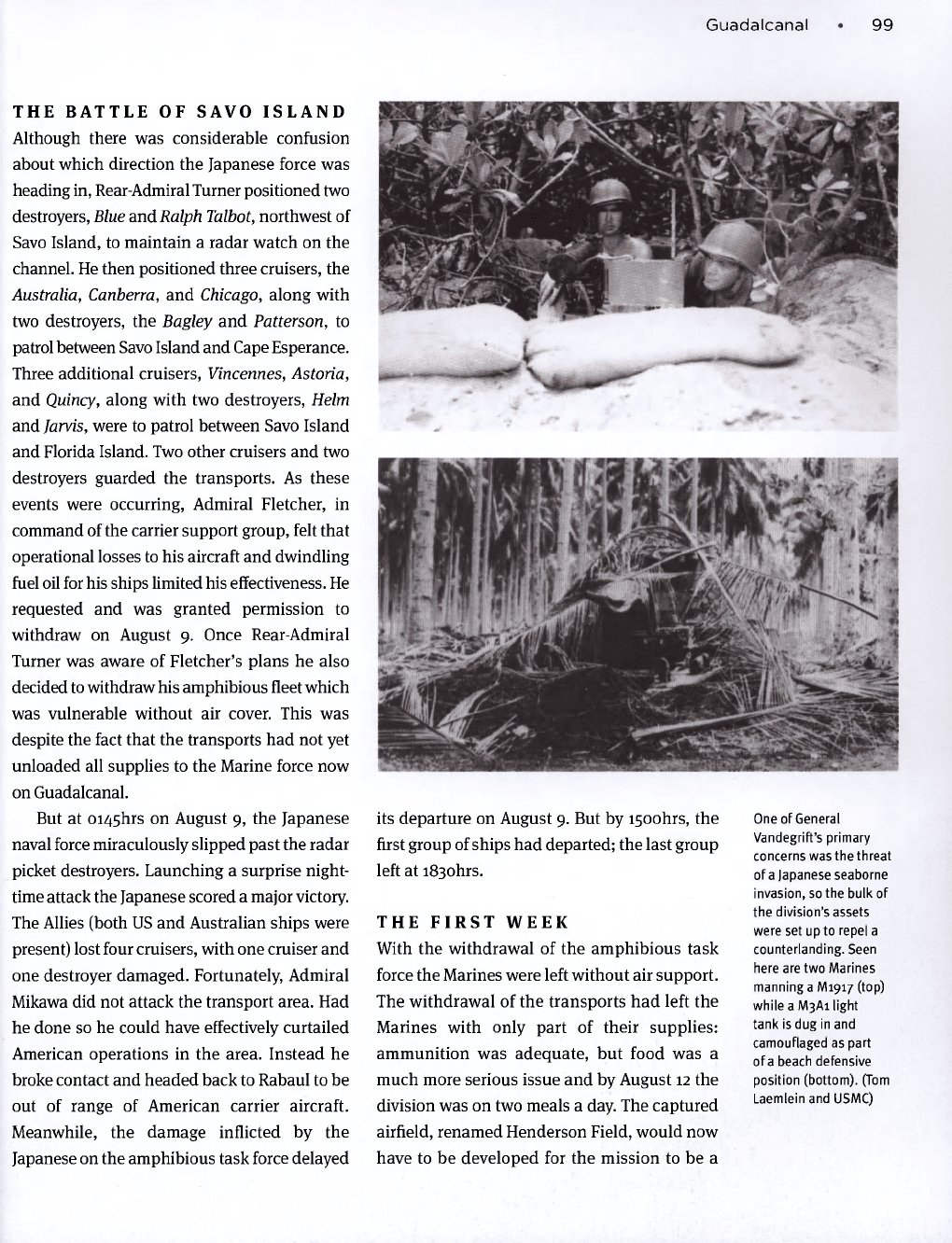
Guadalcanal • 99
THE BATTLE OF SAVO ISLAND
Although there was considerable confusion
about which direction the Japanese force was
heading in, Rear-Admiral Turner positioned two
destroyers, Blue and Ralph Talbot, northwest of
Savo Island, to maintain a radar watch on the
channel. He then positioned three cruisers, the
Australia, Canberra, and Chicago, along with
two destroyers, the Bagley and Patterson, to
patrol between Savo Island and Cape Esperance.
Three additional cruisers, Vincennes, Astoria,
and Quincy, along with two destroyers, Helm
and Jarvis, were to patrol between Savo Island
and Florida Island. Two other cruisers and two
destroyers guarded the transports. As these
events were occurring, Admiral Fletcher, in
command of the carrier support group, felt that
operational losses to his aircraft and dwindling
fuel oil for his ships limited his
effectiveness.
He
requested and was granted permission to
withdraw on August 9. Once Rear-Admiral
Turner was aware of Fletcher's plans he also
decided
to
withdraw his amphibious
fleet
which
was vulnerable without air cover. This was
despite the fact that the transports had not yet
unloaded all supplies to the Marine force now
on Guadalcanal.
But at oi45hrs on August 9, the Japanese
naval force miraculously slipped past the radar
picket destroyers. Launching a surprise night-
time attack the Japanese scored a major victory.
The Allies (both US and Australian ships were
present) lost four cruisers, with one cruiser and
one destroyer damaged. Fortunately, Admiral
Mikawa did not attack the transport area. Had
he done so he could have effectively curtailed
American operations in the area. Instead he
broke contact and headed back to Rabaul to be
out of range of American carrier aircraft.
Meanwhile, the damage inflicted by the
Japanese on the amphibious task force delayed
its departure on August 9. But by isoohrs, the
first group of ships had departed; the last group
left at i830hrs.
THE FIRST WEEK
With the withdrawal of the amphibious task
force the Marines were left without air support.
The withdrawal of the transports had left the
Marines with only part of their supplies:
ammunition was adequate, but food was a
much more serious issue and by August 12 the
division was on two meals a day. The captured
airfield, renamed Henderson Field, would now
have to be developed for the mission to be a
One of General
Vandegrift's primary
concerns was the threat
of a Japanese seaborne
invasion, so the bulk of
the division's assets
were set up to repel a
counterlanding. Seen
here are two Marines
manning a M1917 (top)
while a M3A1 light
tank is dug in and
camouflaged as part
of a beach defensive
position (bottom). (Tom
Laemlein and USMC)
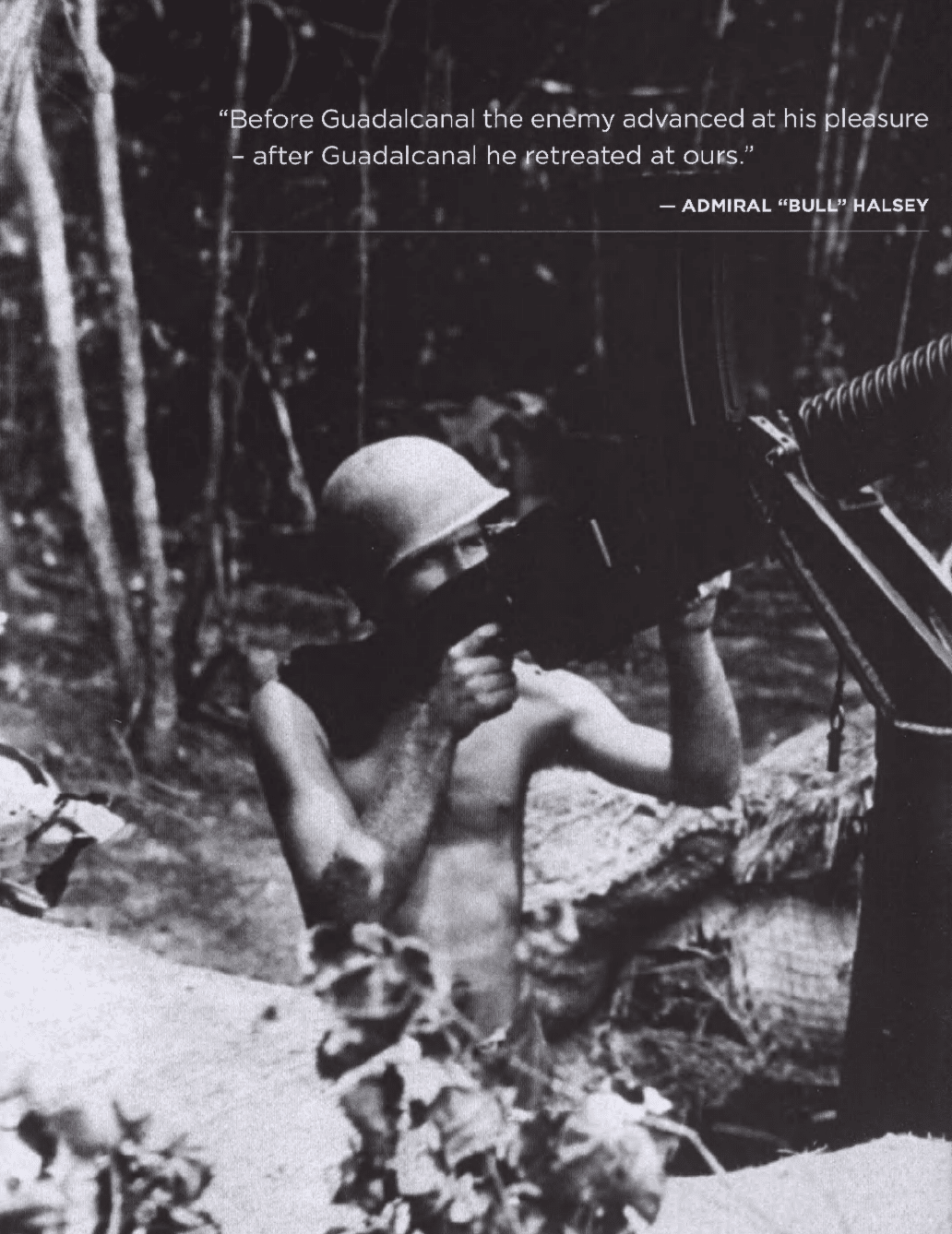
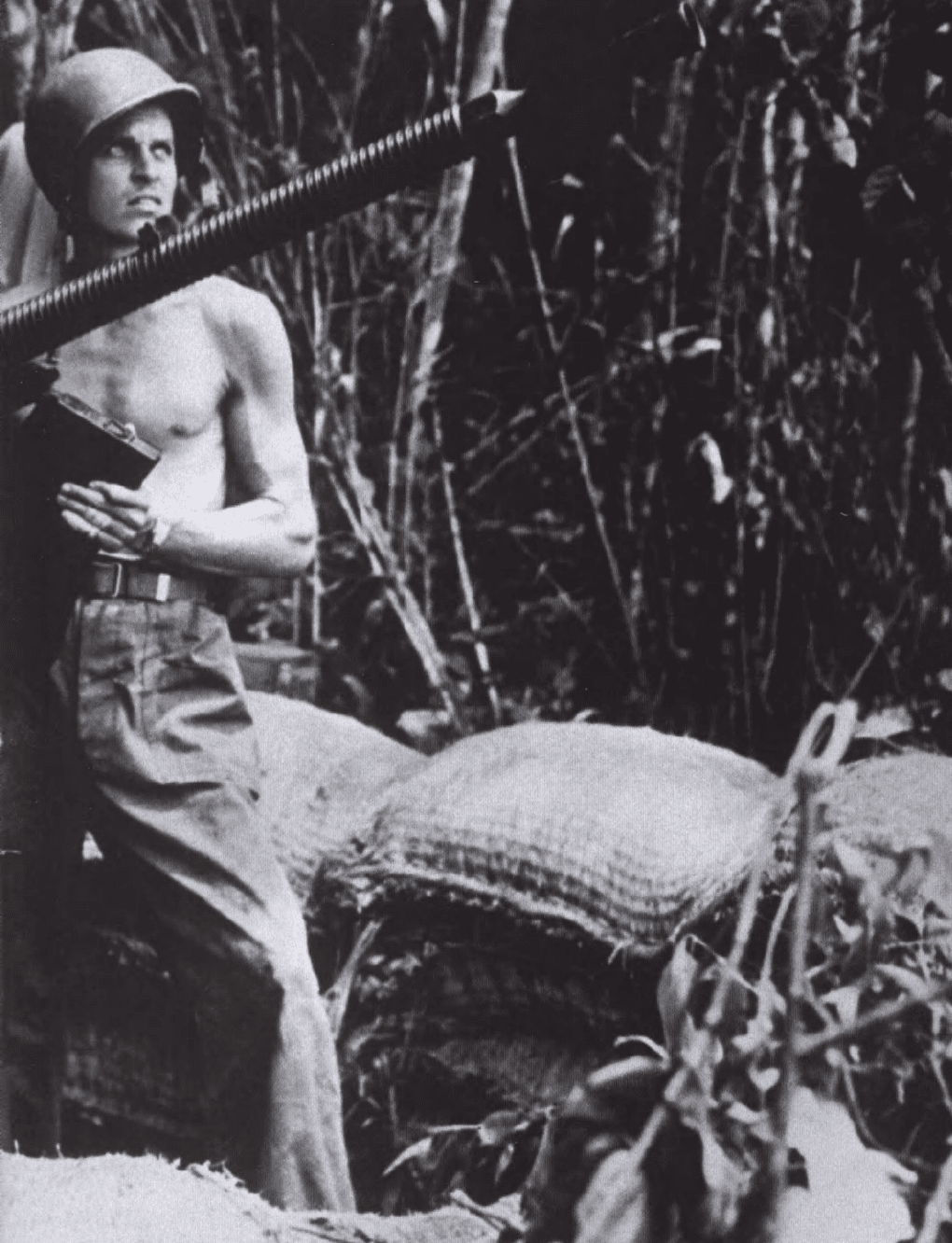
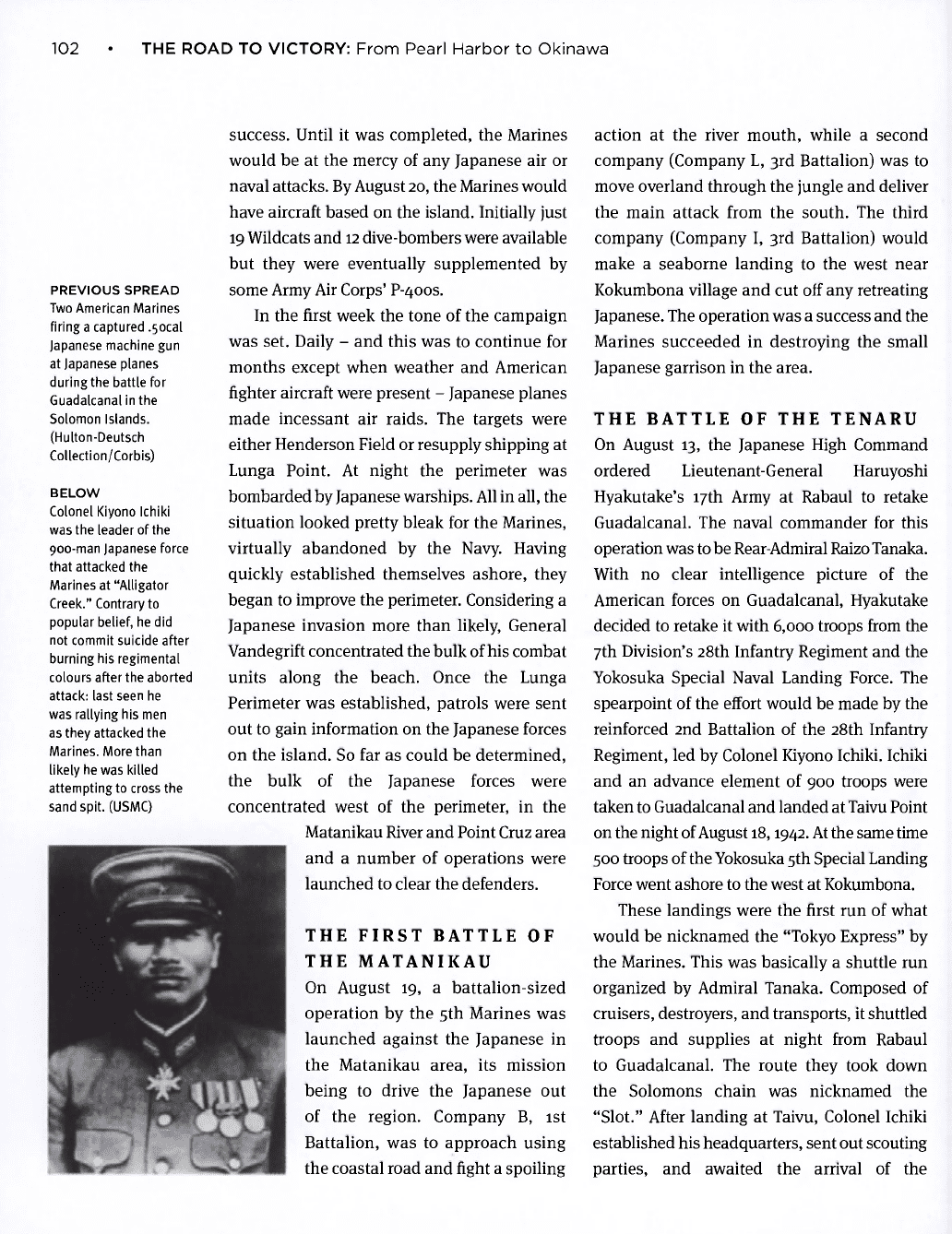
102 • THE ROAD TO VICTORY: From Pearl Harbor to Okinawa
PREVIOUS SPREAD
Two American Marines
firing a captured .socal
Japanese machine gun
at Japanese planes
during the battle for
Guadalcanal in the
Solomon Islands.
(Hulton-Deutsch
Collection/Corbis)
BELOW
Colonel Kiyono Ichiki
was the leader of the
900-man Japanese force
that attacked the
Marines at "Alligator
Creek." Contrary to
popular belief, he did
not commit suicide after
burning his regimental
colours after the aborted
attack: last seen he
was rallying his men
as they attacked the
Marines. More than
likely he was killed
attempting to cross the
sand spit. (USMC)
success. Until it was completed, the Marines
would be at the mercy of any Japanese air or
naval attacks. By August 20, the Marines would
have aircraft based on the island. Initially just
19 Wildcats and 12 dive-bombers were available
but they were eventually supplemented by
some Army Air Corps' P-400S.
In the first week the tone of the campaign
was set. Daily - and this was to continue for
months except when weather and American
fighter aircraft were present - Japanese planes
made incessant air raids. The targets were
either Henderson Field or resupply shipping at
Lunga Point. At night the perimeter was
bombarded by Japanese warships. All in all, the
situation looked pretty bleak for the Marines,
virtually abandoned by the Navy. Having
quickly established themselves ashore, they
began to improve the perimeter. Considering a
Japanese invasion more than likely, General
Vandegrift concentrated the bulk of his combat
units along the beach. Once the Lunga
Perimeter was established, patrols were sent
out to gain information on the Japanese forces
on the island. So far as could be determined,
the bulk of the Japanese forces were
concentrated west of the perimeter, in the
Matanikau River and Point Cruz area
and a number of operations were
launched to clear the defenders.
THE FIRST BATTLE OF
THE MATANIKAU
On August 19, a battalion-sized
operation by the 5th Marines was
launched against the Japanese in
the Matanikau area, its mission
being to drive the Japanese out
of the region. Company B, 1st
Battalion, was to approach using
the coastal road and fight a spoiling
action at the river mouth, while a second
company (Company L, 3rd Battalion) was to
move overland through the jungle and deliver
the main attack from the south. The third
company (Company I, 3rd Battalion) would
make a seaborne landing to the west near
Kokumbona village and cut off any retreating
Japanese. The operation was a success and the
Marines succeeded in destroying the small
Japanese garrison in the area.
THE BATTLE OF THE TENARU
On August 13, the Japanese High Command
ordered Lieutenant-General Haruyoshi
Hyakutake's 17th Army at Rabaul to retake
Guadalcanal. The naval commander for this
operation was to be Rear-Admiral Raizo Tanaka.
With no clear intelligence picture of the
American forces on Guadalcanal, Hyakutake
decided to retake it with 6,000 troops from the
7th Division's 28th Infantry Regiment and the
Yokosuka Special Naval Landing Force. The
spearpoint of the effort would be made by the
reinforced 2nd Battalion of the 28th Infantry
Regiment, led by Colonel Kiyono Ichiki. Ichiki
and an advance element of 900 troops were
taken to Guadalcanal and landed at Taivu Point
on the night of August 18,1942. At the same time
500 troops of the Yokosuka 5th Special Landing
Force went ashore to the west at Kokumbona.
These landings were the first run of what
would be nicknamed the "Tokyo Express" by
the Marines. This was basically a shuttle run
organized by Admiral Tanaka. Composed of
cruisers, destroyers, and transports, it shuttled
troops and supplies at night from Rabaul
to Guadalcanal. The route they took down
the Solomons chain was nicknamed the
"Slot." After landing at Taivu, Colonel Ichiki
established his headquarters, sent out scouting
parties, and awaited the arrival of the
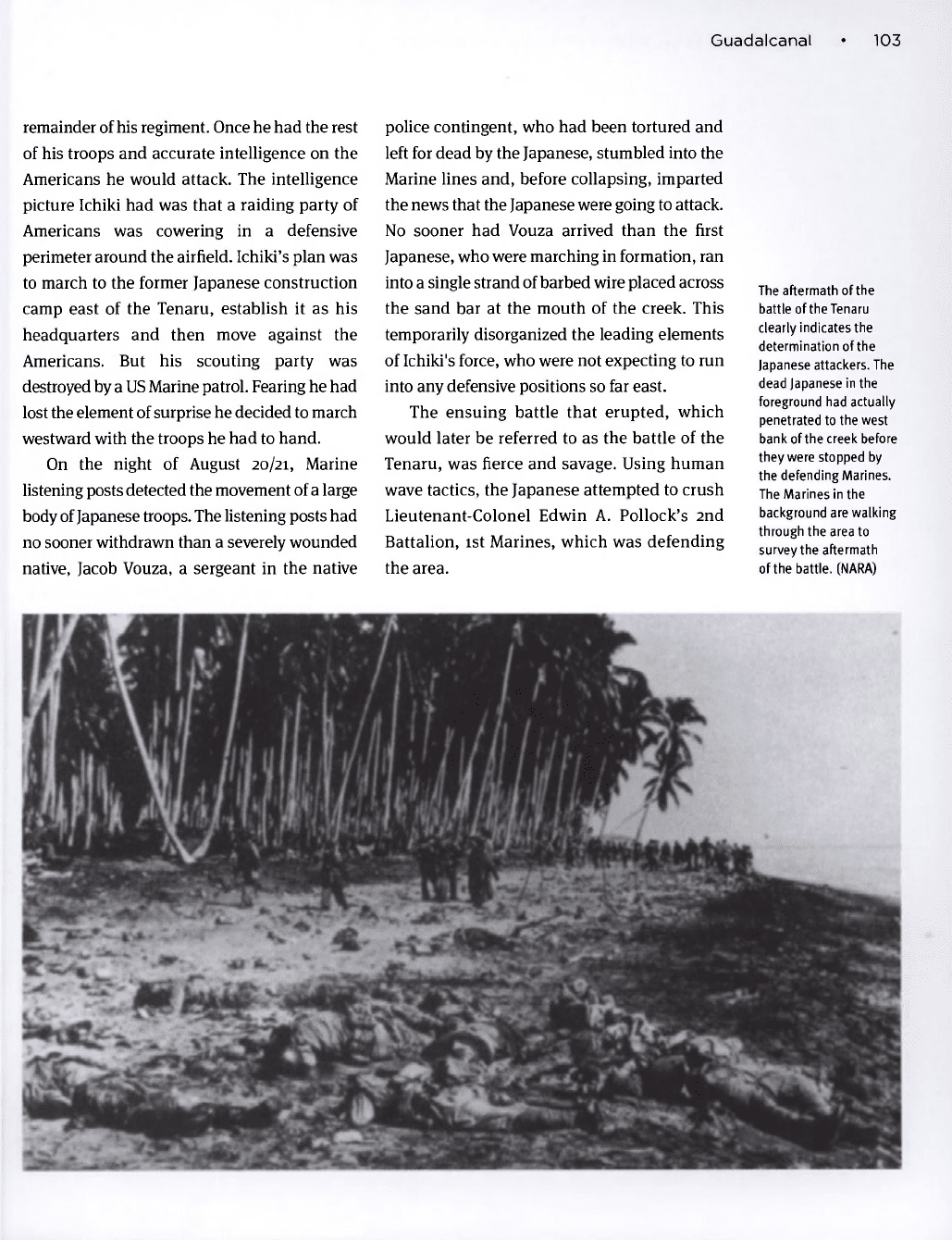
Guadalcanal • 103
remainder of his regiment. Once he had the rest
of his troops and accurate intelligence on the
Americans he would attack. The intelligence
picture Ichiki had was that a raiding party of
Americans was cowering in a defensive
perimeter around the airfield. Ichiki's plan was
to march to the former Japanese construction
camp east of the Tenaru, establish it as his
headquarters and then move against the
Americans. But his scouting party was
destroyed by a US Marine patrol. Fearing he had
lost the element of surprise he decided to march
westward with the troops he had to hand.
On the night of August 20/21, Marine
listening posts detected the movement of a large
body of Japanese troops. The listening posts had
no sooner withdrawn than a severely wounded
native, Jacob Vouza, a sergeant in the native
police contingent, who had been tortured and
left for dead by the Japanese, stumbled into the
Marine lines and, before collapsing, imparted
the news that the Japanese were going to attack.
No sooner had Vouza arrived than the first
Japanese, who were marching in formation, ran
into a single strand of barbed wire placed across
the sand bar at the mouth of the creek. This
temporarily disorganized the leading elements
of Ichiki's force, who were not expecting to run
into any defensive positions so far east.
The ensuing battle that erupted, which
would later be referred to as the battle of the
Tenaru, was fierce and savage. Using human
wave tactics, the Japanese attempted to crush
Lieutenant-Colonel Edwin A. Pollock's 2nd
Battalion, 1st Marines, which was defending
the area.
The aftermath of the
battle of the Tenaru
clearly indicates the
determination of the
japanese attackers. The
dead Japanese in the
foreground had actually
penetrated to the west
bank of the creek before
they were stopped by
the defending Marines.
The Marines in the
background are walking
through the area to
survey the aftermath
of the battle. (NARA)
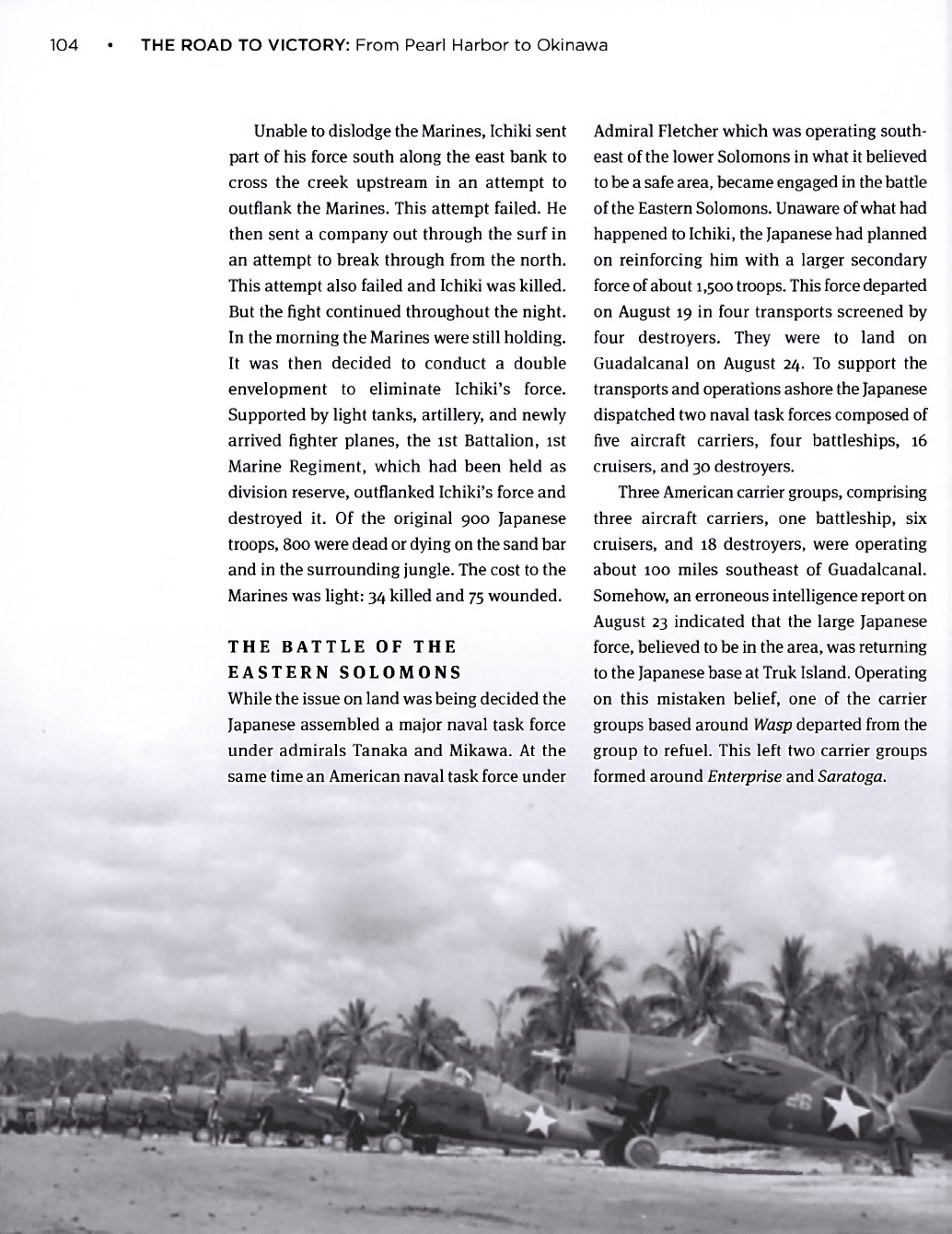
104 • THE ROAD TO VICTORY: From Pearl Harbor to Okinawa
Unable to dislodge the Marines, Ichiki sent
part of his force south along the east bank to
cross the creek upstream in an attempt to
outflank the Marines. This attempt failed. He
then sent a company out through the surf in
an attempt to break through from the north.
This attempt also failed and Ichiki was killed.
But the fight continued throughout the night.
In the morning the Marines were still holding.
It was then decided to conduct a double
envelopment to eliminate Ichiki's force.
Supported by light tanks, artillery, and newly
arrived fighter planes, the ist Battalion, ist
Marine Regiment, which had been held as
division reserve, outflanked Ichiki's force and
destroyed it. Of the original 900 Japanese
troops, 800 were dead or dying on the sand bar
and in the surrounding jungle. The cost to the
Marines was light: 34 killed and 75 wounded.
THE BATTLE OF THE
EASTERN SOLOMONS
While the issue on land was being decided the
Japanese assembled a major naval task force
under admirals Tanaka and Mikawa. At the
same time an American naval task force under
Admiral Fletcher which was operating south-
east of the lower Solomons in what it believed
to be a safe area, became engaged in the battle
of the Eastern Solomons. Unaware of what had
happened to Ichiki, the Japanese had planned
on reinforcing him with a larger secondary
force of about 1,500 troops. This force departed
on August 19 in four transports screened by
four destroyers. They were to land on
Guadalcanal on August 24. To support the
transports and operations ashore the Japanese
dispatched two naval task forces composed of
five aircraft carriers, four battleships, 16
cruisers, and 30 destroyers.
Three American carrier groups, comprising
three aircraft carriers, one battleship, six
cruisers, and 18 destroyers, were operating
about 100 miles southeast of Guadalcanal.
Somehow, an erroneous intelligence report on
August 23 indicated that the large Japanese
force, believed to be in the area, was returning
to the Japanese base at Truk Island. Operating
on this mistaken belief, one of the carrier
groups based around Wasp departed from the
group to refuel. This left two carrier groups
formed around Enterprise and Saratoga.
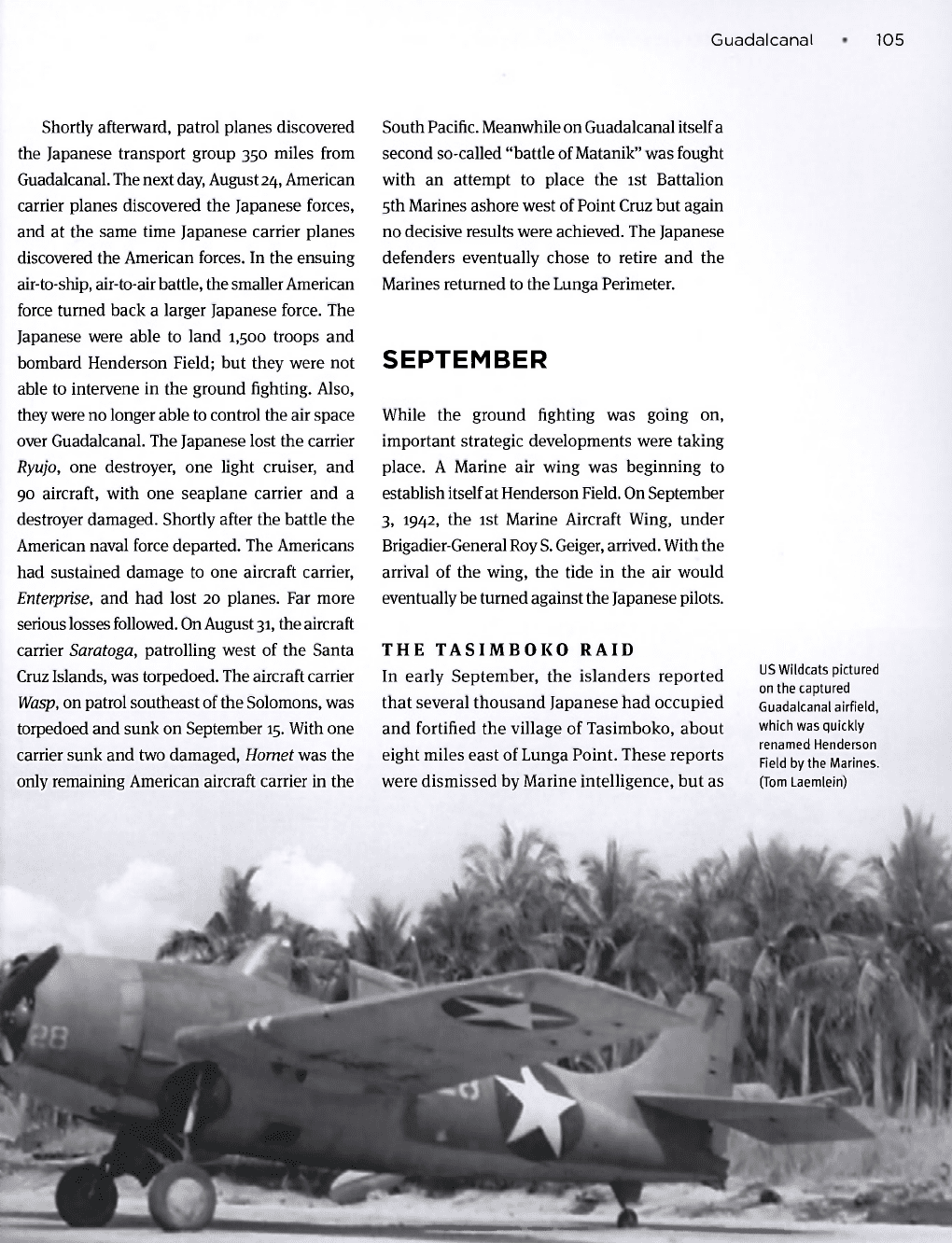
Guadalcanal • 105
South
Pacific.
Meanwhile on Guadalcanal itself a
second so-called "battle of Matanik" was fought
with an attempt to place the ist Battalion
5th Marines ashore west of Point Cruz but again
no decisive results were achieved. The Japanese
defenders eventually chose to retire and the
Marines returned to the Lunga Perimeter.
SEPTEMBER
While the ground fighting was going on,
important strategic developments were taking
place. A Marine air wing was beginning to
establish itself at Henderson Field. On September
3, 1942, the 1st Marine Aircraft Wing, under
Brigadier-General Roy
S.
Geiger, arrived. With the
arrival of the wing, the tide in the air would
eventually be turned against the Japanese pilots.
THE TASIMBOKO RAID
In early September, the islanders reported
that several thousand Japanese had occupied
and fortified the village of Tasimboko, about
eight miles east of Lunga Point. These reports
were dismissed by Marine intelligence, but as
US Wildcats pictured
on the captured
Guadalcanal airfield,
which was quickly
renamed Henderson
Field by the Marines.
(Tom Laemlein)
Shortly afterward, patrol planes discovered
the Japanese transport group 350 miles from
Guadalcanal. The next
day,
August 24, American
carrier planes discovered the Japanese forces,
and at the same time Japanese carrier planes
discovered the American forces. In the ensuing
air-to-ship, air-to-air battle, the smaller American
force turned back a larger Japanese force. The
Japanese were able to land 1,500 troops and
bombard Henderson Field; but they were not
able to intervene in the ground fighting. Also,
they were no longer able to control the air space
over Guadalcanal. The Japanese lost the carrier
Ryujo, one destroyer, one light cruiser, and
90 aircraft, with one seaplane carrier and a
destroyer damaged. Shortly after the battle the
American naval force departed. The Americans
had sustained damage to one aircraft carrier,
Enterprise, and had lost 20 planes. Far more
serious losses followed.
On
August 31, the aircraft
carrier Saratoga, patrolling west of the Santa
Cruz Islands, was torpedoed. The aircraft carrier
Wasp, on patrol southeast of the Solomons, was
torpedoed and sunk on September 15. With one
carrier sunk and two damaged, Hornet was the
only remaining American aircraft carrier in the
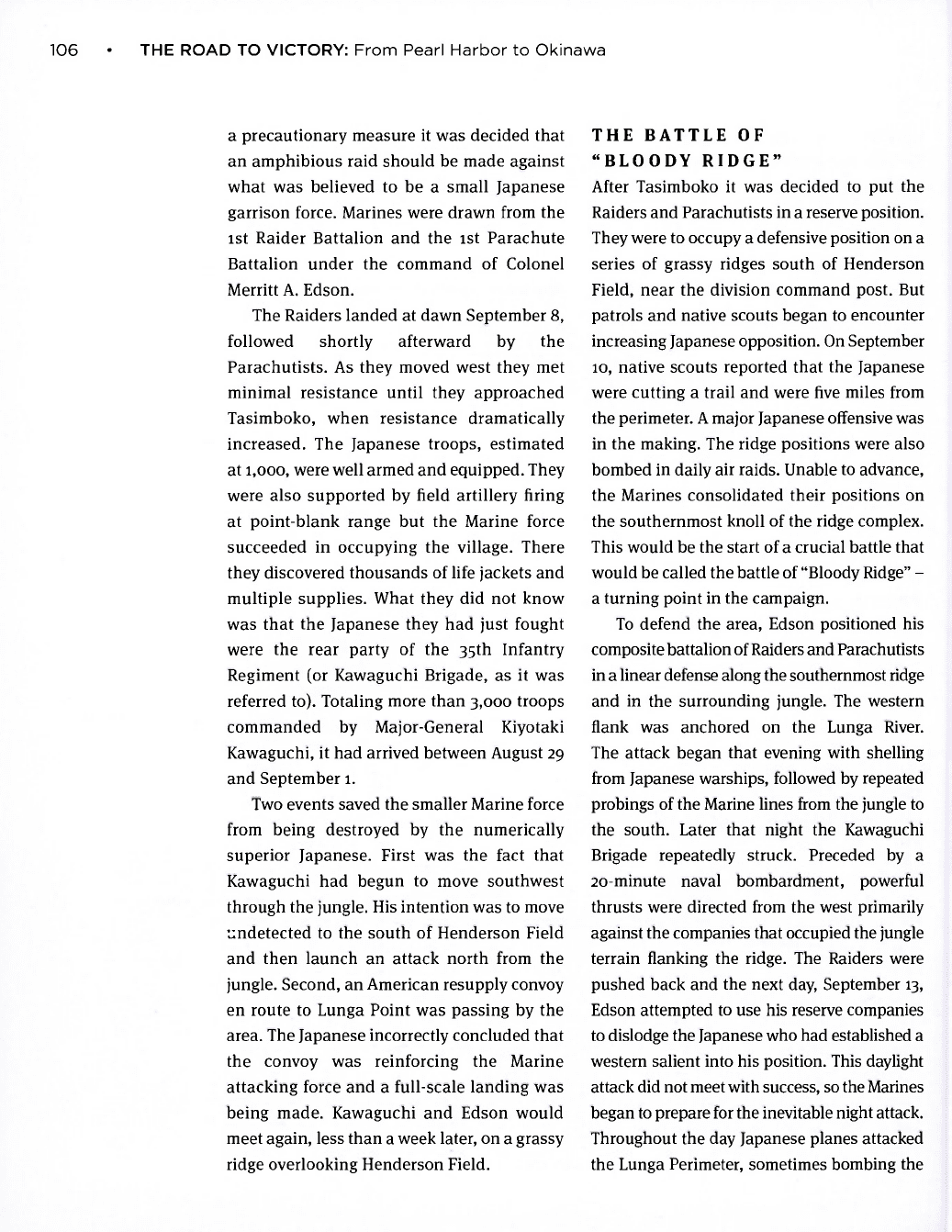
106 • THE ROAD TO VICTORY: From Pearl Harbor to Okinawa
a precautionary measure it was decided that
an amphibious raid should be made against
what was believed to be a small Japanese
garrison force. Marines were drawn from the
ist Raider Battalion and the ist Parachute
Battalion under the command of Colonel
Merritt A. Edson.
The Raiders landed at dawn September 8,
followed shortly afterward by the
Parachutists. As they moved west they met
minimal resistance until they approached
Tasimboko, when resistance dramatically
increased. The Japanese troops, estimated
at 1,000, were well armed and equipped. They
were also supported by field artillery firing
at point-blank range but the Marine force
succeeded in occupying the village. There
they discovered thousands of life jackets and
multiple supplies. What they did not know
was that the Japanese they had just fought
were the rear party of the 35th Infantry
Regiment (or Kawaguchi Brigade, as it was
referred to). Totaling more than 3,000 troops
commanded by Major-General Kiyotaki
Kawaguchi, it had arrived between August 29
and September 1.
Two events saved the smaller Marine force
from being destroyed by the numerically
superior Japanese. First was the fact that
Kawaguchi had begun to move southwest
through the jungle. His intention was to move
undetected to the south of Henderson Field
and then launch an attack north from the
jungle. Second, an American resupply convoy
en route to Lunga Point was passing by the
area. The Japanese incorrectly concluded that
the convoy was reinforcing the Marine
attacking force and a full-scale landing was
being made. Kawaguchi and Edson would
meet again, less than a week later, on a grassy
ridge overlooking Henderson Field.
THE BATTLE OF
"BLOODY RIDGE"
After Tasimboko it was decided to put the
Raiders and Parachutists in a reserve position.
They were to occupy a defensive position on a
series of grassy ridges south of Henderson
Field, near the division command post. But
patrols and native scouts began to encounter
increasing Japanese opposition. On September
10, native scouts reported that the Japanese
were cutting a trail and were five miles from
the perimeter. A major Japanese offensive was
in the making. The ridge positions were also
bombed in daily air raids. Unable to advance,
the Marines consolidated their positions on
the southernmost knoll of the ridge complex.
This would be the start of a crucial battle that
would be called the battle of "Bloody Ridge" -
a turning point in the campaign.
To defend the area, Edson positioned his
composite battalion of Raiders and Parachutists
in a linear defense along the southernmost ridge
and in the surrounding jungle. The western
flank was anchored on the Lunga River.
The attack began that evening with shelling
from Japanese warships, followed by repeated
probings of the Marine lines from the jungle to
the south. Later that night the Kawaguchi
Brigade repeatedly struck. Preceded by a
20-minute naval bombardment, powerful
thrusts were directed from the west primarily
against the companies that occupied the jungle
terrain flanking the ridge. The Raiders were
pushed back and the next day, September 13,
Edson attempted to use his reserve companies
to dislodge the Japanese who had established a
western salient into his position. This daylight
attack did not meet with success, so the Marines
began to prepare for the inevitable night attack.
Throughout the day Japanese planes attacked
the Lunga Perimeter, sometimes bombing the
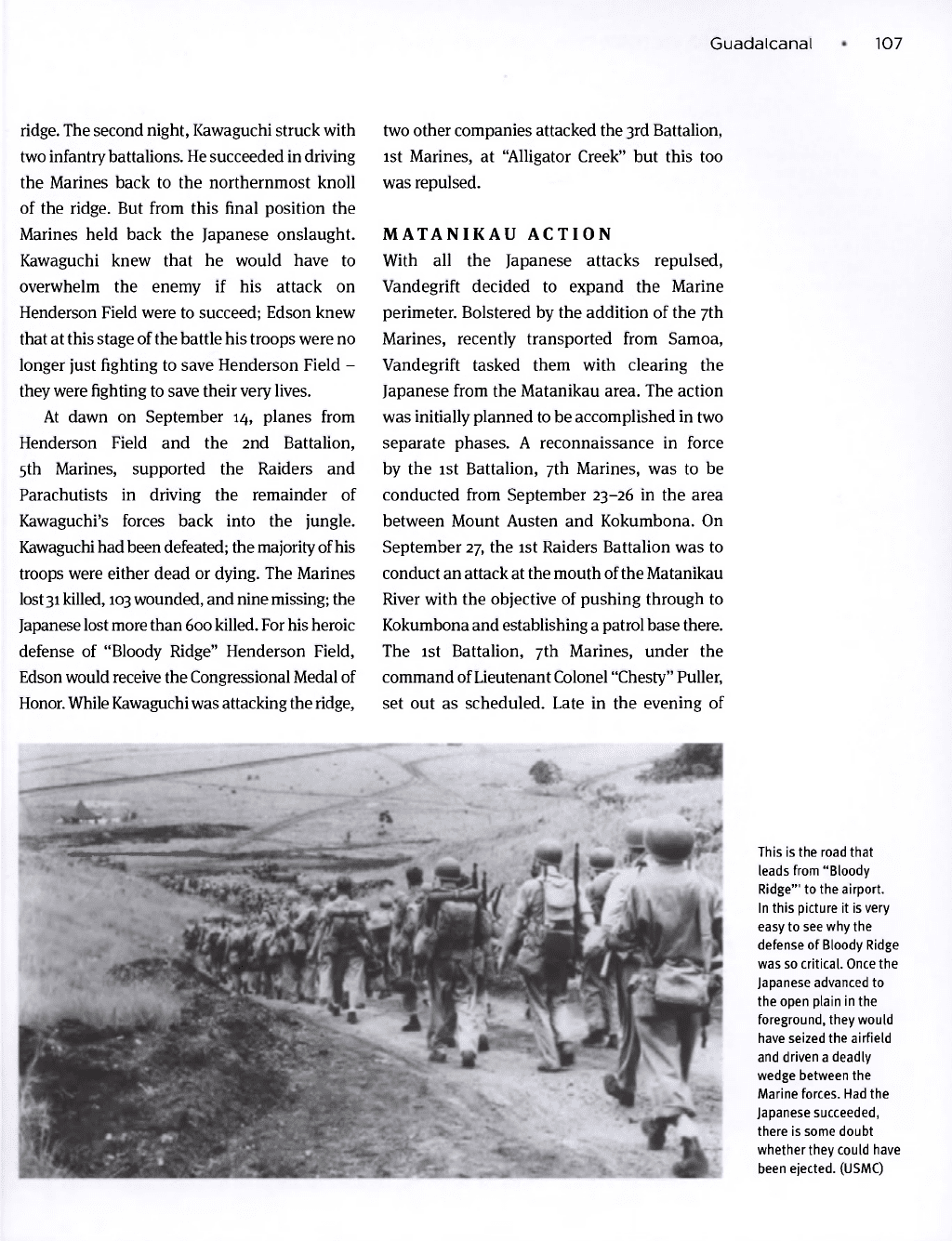
Guadalcanal • 107
ridge. The second night, Kawaguchi struck with
two infantry battalions. He succeeded in driving
the Marines back to the northernmost knoll
of the ridge. But from this final position the
Marines held back the Japanese onslaught.
Kawaguchi knew that he would have to
overwhelm the enemy if his attack on
Henderson Field were to succeed; Edson knew
that at this stage of the battle his troops were no
longer just fighting to save Henderson Field -
they were fighting to save their very lives.
At dawn on September 14, planes from
Henderson Field and the 2nd Battalion,
5th Marines, supported the Raiders and
Parachutists in driving the remainder of
Kawaguchi's forces back into the jungle.
Kawaguchi had been defeated; the majority of his
troops were either dead or dying. The Marines
lost 31 killed, 103 wounded, and nine missing; the
Japanese lost more than 600 killed. For his heroic
defense of "Bloody Ridge" Henderson Field,
Edson would receive the Congressional Medal of
Honor. While Kawaguchi was attacking the ridge,
two other companies attacked the 3rd Battalion,
1st Marines, at "Alligator Creek" but this too
was repulsed.
MATANIKAU ACTION
With all the Japanese attacks repulsed,
Vandegrift decided to expand the Marine
perimeter. Bolstered by the addition of the 7th
Marines, recently transported from Samoa,
Vandegrift tasked them with clearing the
Japanese from the Matanikau area. The action
was initially planned to be accomplished in two
separate phases. A reconnaissance in force
by the 1st Battalion, 7th Marines, was to be
conducted from September 23-26 in the area
between Mount Austen and Kokumbona. On
September 27, the 1st Raiders Battalion was to
conduct an attack at the mouth of
the
Matanikau
River with the objective of pushing through to
Kokumbona and establishing a patrol base there.
The 1st Battalion, 7th Marines, under the
command of Lieutenant Colonel "Chesty" Puller,
set out as scheduled. Late in the evening of
This is the road that
leads from "Bloody
Ridge'" to the airport.
In this picture it is very
easy to see why the
defense of Bloody Ridge
was so critical. Once the
Japanese advanced to
the open plain in the
foreground, they would
have seized the airfield
and driven a deadly
wedge between the
Marine forces. Had the
Japanese succeeded,
there is some doubt
whether they could have
been ejected. (USMC)
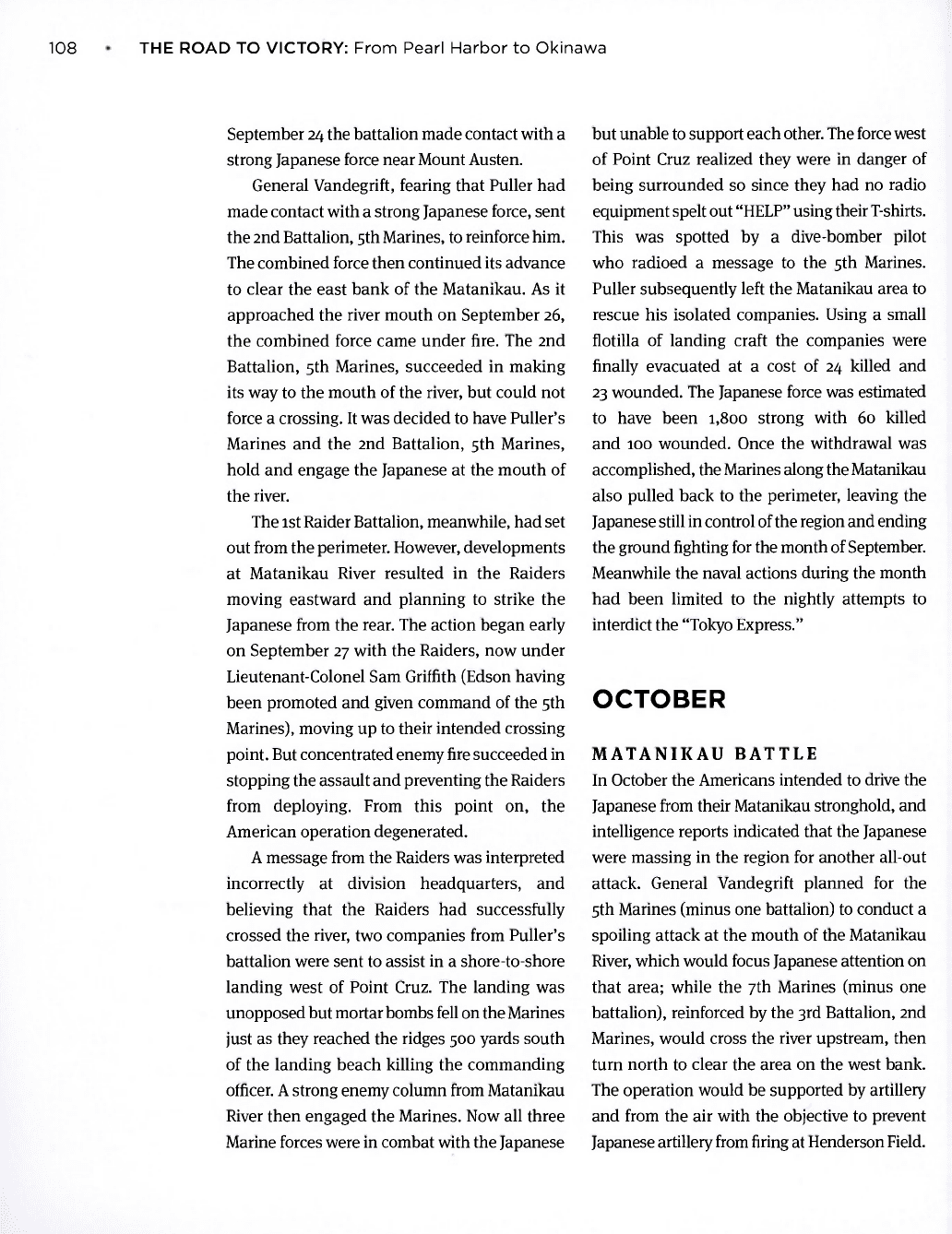
108 •
THE ROAD TO VICTORY: From Pearl Harbor to Okinawa
September 24 the battalion made contact with a
strong Japanese force near Mount Austen.
General Vandegrift, fearing that Puller had
made contact with a strong Japanese force, sent
the 2nd Battalion, 5th Marines, to reinforce him.
The combined force then continued its advance
to clear the east bank of the Matanikau. As it
approached the river mouth on September 26,
the combined force came under fire. The 2nd
Battalion, 5th Marines, succeeded in making
its way to the mouth of the river, but could not
force a crossing. It was decided to have Puller's
Marines and the 2nd Battalion, 5th Marines,
hold and engage the Japanese at the mouth of
the river.
The 1st Raider Battalion, meanwhile, had set
out from the perimeter. However, developments
at Matanikau River resulted in the Raiders
moving eastward and planning to strike the
Japanese from the rear. The action began early
on September 27 with the Raiders, now under
Lieutenant-Colonel Sam Griffith (Edson having
been promoted and given command of the 5th
Marines), moving up to their intended crossing
point. But concentrated enemy fire succeeded in
stopping the assault and preventing the Raiders
from deploying. From this point on, the
American operation degenerated.
A message from the Raiders was interpreted
incorrectly at division headquarters, and
believing that the Raiders had successfully
crossed the river, two companies from Puller's
battalion were sent to assist in a shore-to-shore
landing west of Point Cruz. The landing was
unopposed but mortar bombs fell on the Marines
just as they reached the ridges 500 yards south
of the landing beach killing the commanding
officer.
A strong enemy column from Matanikau
River then engaged the Marines. Now all three
Marine forces were in combat with the Japanese
but unable to support each other. The
force
west
of Point Cruz realized they were in danger of
being surrounded so since they had no radio
equipment spelt out "HELP" using their T-shirts.
This was spotted by a dive-bomber pilot
who radioed a message to the 5th Marines.
Puller subsequently left the Matanikau area to
rescue his isolated companies. Using a small
flotilla of landing craft the companies were
finally evacuated at a cost of 24 killed and
23 wounded. The Japanese force was estimated
to have been 1,800 strong with 60 killed
and 100 wounded. Once the withdrawal was
accomplished, the Marines along the Matanikau
also pulled back to the perimeter, leaving the
Japanese still in control of the region and ending
the ground fighting for the month of September.
Meanwhile the naval actions during the month
had been limited to the nightly attempts to
interdict the "Tokyo Express."
OCTOBER
MATANIKAU BATTLE
In October the Americans intended to drive the
Japanese from their Matanikau stronghold, and
intelligence reports indicated that the Japanese
were massing in the region for another all-out
attack. General Vandegrift planned for the
5th Marines (minus one battalion) to conduct a
spoiling attack at the mouth of the Matanikau
River, which would focus Japanese attention on
that area; while the 7th Marines (minus one
battalion), reinforced by the 3rd Battalion, 2nd
Marines, would cross the river upstream, then
turn north to clear the area on the west bank.
The operation would be supported by artillery
and from the air with the objective to prevent
Japanese artillery
from
firing at Henderson Field.
